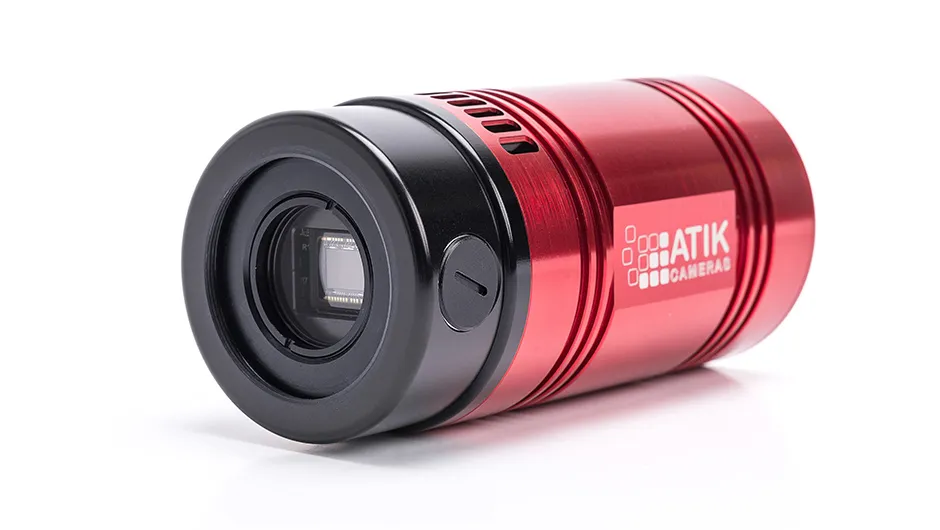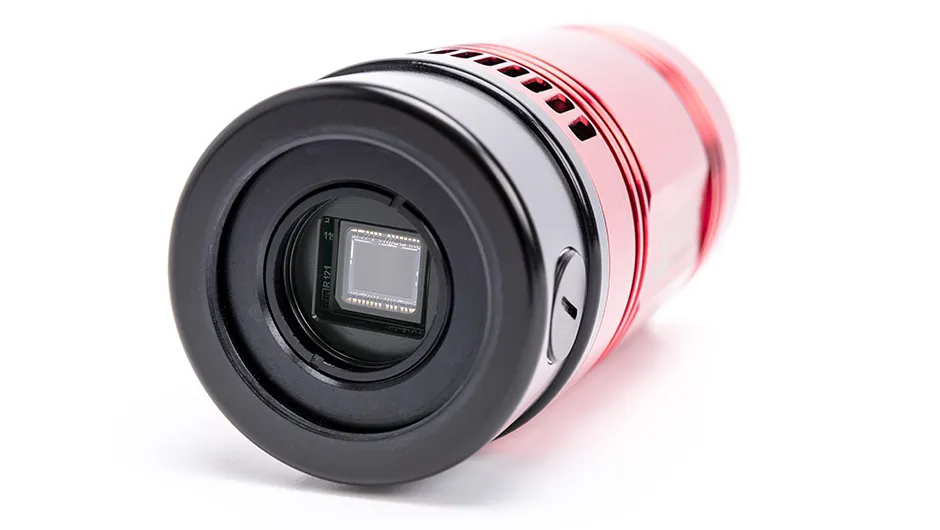There is always an element of excitement among astrophotographers when a new camera is released, and the arrival of Atik’s 414EX CCD is no exception.Astro imagers constantly look for increased sensitivity and larger sensors, and this one claims to meet the first head on.
Monochrome and colour variants of this camera are available – it is the former we are reviewing here.The 414EX is attractively finished in a high-gloss electric red with contrasting black trim.
There are minimal connections at the rear of the cylindrical alloy casing – just a 12V power input and a USB Mini B socket.
Included in the box are a 1.25-inch nosepiece with dust cover, 3m USB cable, 1.8m cigar lighter power cable, software CD, a tool to remove the desiccant plug and an instruction manual.
The software was quick and simple to load, and immediately recognised the camera.
We carried out a set of test images using the supplied Artemis image capture software to confirm that the camera was functioning properly, but for our real imaging sessions we used the supplied ASCOM driver and controlled the camera via MaxIm DL.
We had no problems at all using this setup and MaxIm DL gave us access to all of the camera’s functions.
The CCD sensor in this camera is relatively small, with an 11mm diagonal; using a refractor with a focal length of 509mm yielded a field of view of 1º by 0.75º.However, what this chip lacks in size it more than makes up for in sensitivity.
We were very impressed with its ability to collect photons without adding much in the way of unwanted thermal noise.There are also some advantages to a smaller sensor like this, especially for those starting out in deep-sky imaging.
Because the field of view is relatively small, only the central portion of the light cone is intercepted.This is the region with the fewest of optical distortions – things such as field curvature in refractors and coma in reflectors – so correction is often not required.
The small size also means that 1.25-inch filters (rather than their pricier 2-inch counterparts) are perfectly suitable, and the lower cost of smaller sensors makes the transition to a full astro-CCD camera a little easier on the pocket too.

Filtering the Universe
Because of the timing of the review we carried out most of our imaging under moonlit skies, so it made sense to use narrowband filtering for our images.
Our setup also included a manual five-position filter wheel, attached with a male to male T-adaptor and a 22mm T-extension tube to obtain the correct spacing of 55mm with our standard focal reducer, and a trio of filters – Ha, OIII and SII.
Our target was a small section of the popular Soul Nebula, IC 1848, an emission nebula in the constellation of Cassiopeia.
We generated a false-colour image of the nebula in the Hubble Palette by mapping SII to red, Ha to green and OIII to blue, producing a very satisfactory image.
We also captured some test images of the quarter Moon to gauge how well the ‘anti-bloom gate’ worked at shorter exposures and were pleasantly surprised to find no streaks emanating from this bright source.
An anti-bloom gate is a feature built into a CCD camera to stop vertical streaks from bright objects, caused when the ‘well-depth’ is exceeded and electric charge bleeds onto adjacent pixels.
Although not designed for lunar imaging, we discovered that this camera can comfortably be pressed into service for this purpose.
Overall we were very impressed with the Atik 414EX camera as it worked straight out of the box, was quick to set up and begin imaging, and was very sensitive indeed.
We would recommend this camera to deep-sky imagers making the transition from a DSLR to a fully fledged cooled CCD.

Chip off the old block
The Atik 414EX’s Sony ICX825 EXview HAD II sensor has the same dimensions as the incredibly popular Sony ICX285 sensor, which has been used in numerous CCD cameras.However, the new chip is even more sensitive, making it a natural successor.
The sensor is approximately 8.9x6.7mm, giving a diagonal measurement of 11mm.Each pixel is 6.45µm square, which is relatively large and adds to the high sensitivity of the sensor.
As a departure from normal practice, the sensor comes as a plastic package rather than the usual ceramic package used for most sensors of this type.
However, any fears about this impacting on the effectiveness of the Peltier cooling were soon allayed, as our tests showed that it took just one minute and nine seconds to reach 20ºC below the ambient temperature of 11.9ºC.
With regard to sensitivity whilst imaging, we were so impressed with the way the sensor performed, and its minimal thermal noise, that we didn’t feel the need to take dark calibration frames.

Desiccant plug
The sensor is mounted in a sealed chamber to keep moisture and dust at bay, and this is augmented by a desiccant insert that extracts any moisture from inside the chamber.Occasionally, this desiccant needs to be rejuvenated by heating it in an oven; the supplied tool makes it easy to remove the plug and access the dessicant to do this.
Software
The excellent Artemis image capture software allows you to both control the camera and set up multiple imaging sequences.However, an ASCOM driver is also supplied, allowing control by third party software such as MaxIm DL and AstroArt.Atik’s Dawn software is also included to calibrate, align and stack your images.
Set-point Peltier cooling
The Atik 414EX features set-point cooling down to 30ºC below ambient, assisted by a cooling fan mounted on the rear of the casing with inlet ports towards the front.Cooling is vital for keeping the sensor’s thermal noise under control during long exposures as this results in cleaner images.

Slim casing
The beautifully finished alloy casing is just 60mm in diameter, giving the camera a very small profile, and with a weight of only 381g it would be suitable for mounting on the front of a Fastar/Hyperstar or Rowe-Ackermann telescope.Despite its diminutive size, the camera has a robust feel to it.
1.25-inch and T connections
The Atik 414EX is supplied with a 1.25-inch nosepiece that screws onto the front of the camera via a 42mm T-thread.This means that the camera can be attached directly to a standard eyepiece holder on your focuser or to a focal reducer, field flattener or coma corrector using an all-threaded connection for additional stability.
Vital stats
Price: £1019.00
Weight: 381g
Supplier: Atik Cameras
Telephone: 01603 740397
Website:www.atik-cameras.com
This review originally appeared in the July 2015 issue of BBC Sky at Night Magazine.
